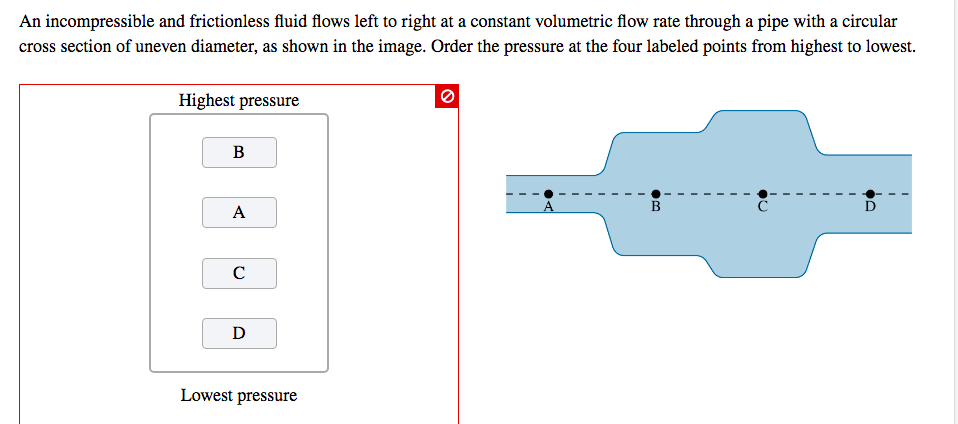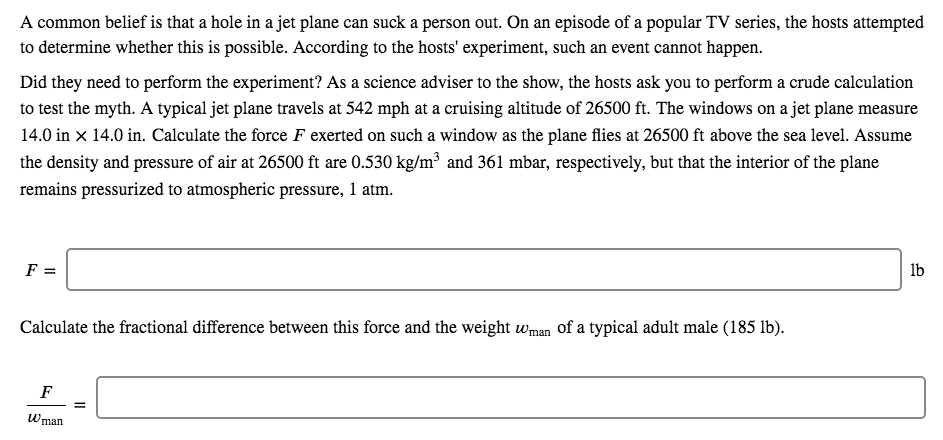
Physics for Scientists and Engineers: Foundations and Connections
1st Edition
ISBN: 9781133939146
Author: Katz, Debora M.
Publisher: Cengage Learning
expand_more
expand_more
format_list_bulleted
Question
thumb_up100%
please answer both questions

Transcribed Image Text:An incompressible and frictionless fluid flows left to right at a constant volumetric flow rate through a pipe with a circular
cross section of uneven diameter, as shown in the image. Order the pressure at the four labeled points from highest to lowest.
Highest pressure
B
A
D
Lowest pressure

Transcribed Image Text:A common belief is that a hole in a jet plane can suck a person out. On an episode of a popular TV series, the hosts attempted
to determine whether this is possible. According to the hosts' experiment, such an event cannot happen.
Did they need to perform the experiment? As a science adviser to the show, the hosts ask you to perform a crude calculation
to test the myth. A typical jet plane travels at 542 mph at a cruising altitude of 26500 ft. The windows on a jet plane measure
14.0 in x 14.0 in. Calculate the force F exerted on such a window as the plane flies at 26500 ft above the sea level. Assume
the density and pressure of air at 26500 ft are 0.530 kg/m³ and 361 mbar, respectively, but that the interior of the plane
remains pressurized to atmospheric pressure, 1 atm.
lb
Calculate the fractional difference between this force and the weight wman of a typical adult male (185 lb).
Wman
Expert Solution
This question has been solved!
Explore an expertly crafted, step-by-step solution for a thorough understanding of key concepts.
This is a popular solution
Trending nowThis is a popular solution!
Step by stepSolved in 4 steps with 3 images

Knowledge Booster
Learn more about
Need a deep-dive on the concept behind this application? Look no further. Learn more about this topic, physics and related others by exploring similar questions and additional content below.Similar questions
- An ideal fluid flows through a horizontal pipe whose diameter varies along its length. Measurements would indicate that the sum of the kinetic energy per unit volume and pressure at different sections of the pipe would (a) decrease as the pipe diameter increases, (b) increase as the pipe diameter increases, (c) increase as the pipe diameter decreases, (d) decrease as the pipe diameter decreases, or (e) remain the same as the pipe diameter changes.arrow_forwardReview. The tank in Figure P15.13 is filled with water of depth d = 2.00 m. At the bottom of one sidewall is a rectangular hatch of height h = 1.00 m and width w = 2.00 m that is hinged at the top of the hatch. (a) Determine the magnitude of the force the water exerts on the hatch. (b) Find the magnitude of the torque exerted by the water about the hinges.arrow_forwardA horizontal pipe 10.0 cm in diameter has a smooth reduction to a pipe 5.00 cm in diameter. If the pressure of the water in the larger pipe is 8.00 104 Pa and the pressure in the smaller pipe is 6.00 104 Pa, at what rate does water flow through the pipes?arrow_forward
- Water enters a smooth, horizontal tube with a speed of 2.0 m/s and emerges out of the tube with a speed of 8.0 m/s. Each end of the tube has a different cross-sectional radius. Find the ratio of the entrance radius to the exit radius.arrow_forwardReview. The tank in Figure P15.13 is filled with water of depth d. At the bottom of one sidewall is a rectangular hatch of height h and width w that is hinged at the top of the hatch. (a) Determine the magnitude of the force the water exerts on the hatch. (b) Find the magnitude of the torque exerted by die water about die hinges.arrow_forward(a) Verify that a 19.0% decrease in laminar flow through a tube is caused by a 5.00% decrease in radius, assuming that all other factors remain constant. (b) What increase in flow is obtained from a 5.00% increase in radius, again assuming all other factors remain constant?arrow_forward
- A fire hose has an inside diameter of 6.40 cm. Suppose such a hose caries a flow of 40.0 L/s starting at a gauge pressure of 1.62106 N/m2. The hose goes 10.0 m up a ladder to a nozzle having an inside diameter of 3.00 cm. Calculate the Reynolds numbers for flow in the fire hose and nozzle to show that flow in each must be turbulent.arrow_forwardAn incompressible, nonviscous fluid is initially at rest in the vertical portion of the pipe shown in Figure P15.61a, where L = 2.00 m. When the valve is opened, the fluid flows into the horizontal section of the pipe. What is the fluids speed when all the fluid is in the horizontal section as shown in Figure P15.61b? Assume the cross-sectional area of the entire pipe is constant. Figure P15.61arrow_forwardFluid originally flows through a tube at a rate of 100 cm3/s. To illustrate the sensitivity of flow rate to various factors, calculate be new flow rate for following changes with all other factors remaining the same as in original conditions. (a) Pressure difference increases by a factor of 1.50. (b) A new fluid wit 3.00 times greater viscosity is substituted. (c) The tube is replaced by one having 4.00 times the length. (d) Another tube used with a 0.100 times the original. (e) Yet another tube is substituted with a radius 0.100 times the original and half length, and pressure difference is increased by factor of 1.50.arrow_forward
- Figure P15.52 shows a Venturi meter, which may be used to measure the speed of a fluid. It consists of a Venturi tube through which the fluid moves and a manometer used to measure the pressure difference between regions 1 and 2. The fluid of density tube moves from left to right in the Venturi tube. Its speed in region 1 is v1, and its speed in region 2 is v2. The necks cross-sectional area is A2, and the cross-sectional area of the rest of the tube is A1. The manometer contains a fluid of density mano. a. Do you expect the fluid to be higher on the left side or the right side of the manometer? b. The speed v2 of the fluid in the neck comes from measuring the difference between the heights (yR yL) of the fluid on the two sides of manometer. Derive an expression for v2 in terms of (yR yL), A1, A2, tube, and mano. FIGURE P15.52arrow_forwardA large storage tank with an open top is filled to a height h0. The tank is punctured at a height h above the bottom of the tank (Fig. P15.39). Find an expression for how far from the tank the exiting stream lands. Figure P15.39arrow_forwardAn oil gusher shoots crude oil 25.0 m into the air through a pipe with a 0.100-m diameter. Neglecting air resistance but not the resistance of the pipe, and assuming laminar flow, calculate the gauge pressure at the entrance of the 50.0-m-long vertical pipe. Take the density of the oil to be 900 kg/m3 and its viscosity to be 1.00 (N/m2) s (or 1.00 Pa s). Note that you must take into account the pressure due to the 50.0-m column of oil in the pipe.arrow_forward
arrow_back_ios
SEE MORE QUESTIONS
arrow_forward_ios
Recommended textbooks for you
 Physics for Scientists and Engineers: Foundations...PhysicsISBN:9781133939146Author:Katz, Debora M.Publisher:Cengage Learning
Physics for Scientists and Engineers: Foundations...PhysicsISBN:9781133939146Author:Katz, Debora M.Publisher:Cengage Learning Principles of Physics: A Calculus-Based TextPhysicsISBN:9781133104261Author:Raymond A. Serway, John W. JewettPublisher:Cengage Learning
Principles of Physics: A Calculus-Based TextPhysicsISBN:9781133104261Author:Raymond A. Serway, John W. JewettPublisher:Cengage Learning University Physics Volume 1PhysicsISBN:9781938168277Author:William Moebs, Samuel J. Ling, Jeff SannyPublisher:OpenStax - Rice University
University Physics Volume 1PhysicsISBN:9781938168277Author:William Moebs, Samuel J. Ling, Jeff SannyPublisher:OpenStax - Rice University Physics for Scientists and Engineers, Technology ...PhysicsISBN:9781305116399Author:Raymond A. Serway, John W. JewettPublisher:Cengage Learning
Physics for Scientists and Engineers, Technology ...PhysicsISBN:9781305116399Author:Raymond A. Serway, John W. JewettPublisher:Cengage Learning An Introduction to Physical SciencePhysicsISBN:9781305079137Author:James Shipman, Jerry D. Wilson, Charles A. Higgins, Omar TorresPublisher:Cengage Learning
An Introduction to Physical SciencePhysicsISBN:9781305079137Author:James Shipman, Jerry D. Wilson, Charles A. Higgins, Omar TorresPublisher:Cengage Learning College PhysicsPhysicsISBN:9781938168000Author:Paul Peter Urone, Roger HinrichsPublisher:OpenStax College
College PhysicsPhysicsISBN:9781938168000Author:Paul Peter Urone, Roger HinrichsPublisher:OpenStax College

Physics for Scientists and Engineers: Foundations...
Physics
ISBN:9781133939146
Author:Katz, Debora M.
Publisher:Cengage Learning

Principles of Physics: A Calculus-Based Text
Physics
ISBN:9781133104261
Author:Raymond A. Serway, John W. Jewett
Publisher:Cengage Learning

University Physics Volume 1
Physics
ISBN:9781938168277
Author:William Moebs, Samuel J. Ling, Jeff Sanny
Publisher:OpenStax - Rice University

Physics for Scientists and Engineers, Technology ...
Physics
ISBN:9781305116399
Author:Raymond A. Serway, John W. Jewett
Publisher:Cengage Learning

An Introduction to Physical Science
Physics
ISBN:9781305079137
Author:James Shipman, Jerry D. Wilson, Charles A. Higgins, Omar Torres
Publisher:Cengage Learning

College Physics
Physics
ISBN:9781938168000
Author:Paul Peter Urone, Roger Hinrichs
Publisher:OpenStax College